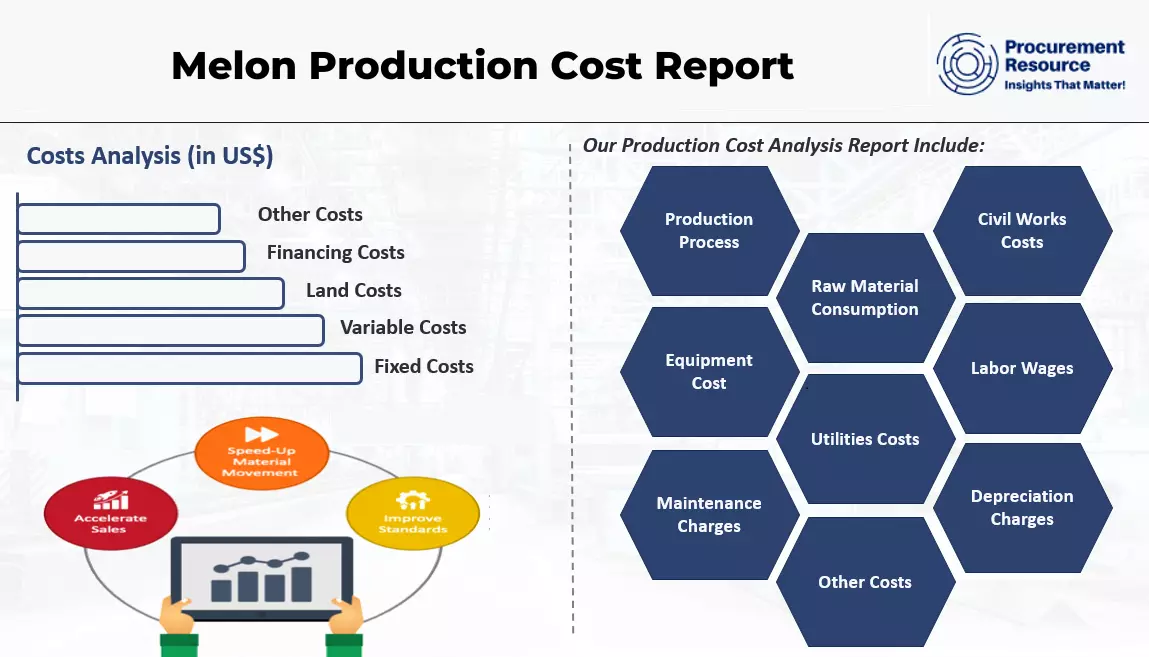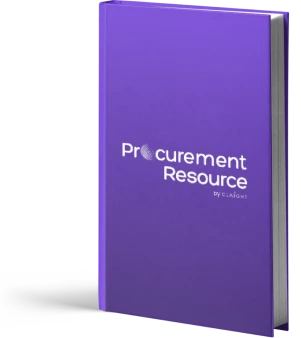Melon Production Cost Reports
Agriculture, Farming and Commodity
The report provides a detailed production cost analysis for Melon. It encompasses all critical aspects necessary for Melon production, including the cost of Melon production, Melon production cost model, and other extensive details. These encompass production processes, raw material requirements, utility requirements, infrastructure needs, machinery and technology requirements, manpower requirements, packaging requirements, transportation requirements, and more.

Melons are a nutrient-dense variety of fruit that are widely used as a flavoring component to produce food products. They are particularly refreshing during the summer months. With high water content and a subtly sweet flavor, the fruit often has yellowish flesh. Essential nutrients found in Melons encompass vitamins A, C, B1, B3, B5, and B6. Additionally, it is a source of dietary fibers, carbohydrates, and a variety of minerals such as magnesium, manganese, zinc, calcium, and iron.
Consuming Melon during the sweltering summer aids in keeping the body hydrated. The fruit not only fortifies the immune system but may also promote better vision. An added advantage is its potassium content, vital for regulating blood pressure and ensuring heart health. Furthermore, the fruit can support a healthy digestive system, contributing to overall well-being.
Melons contain a compound known as adenosine which is recognized for its blood-thinning properties, which can help in preventing clotting issues within the cardiovascular system. It is used in the manufacture of medicinal products which facilitates its market expansion in the medical sector. Beyond fresh consumption, Melon is utilized in the creation of commercially available food products such as juices and ice creams.
Its association with the food industry extends to flavoring applications as well. Additionally, industrial Melon procurement is governed by various factors, including the climate and growing conditions, quality standards, supply chain management (transportation logistics, storage facilities, etc.), cost management and sustainability practices, etc. Therefore, Melons are an important raw resource in many industries, including food, beverage, health, and cosmetics. Their nutritional content, adaptability, and health advantages make them a valuable commodity.
Raw Material for Melon Production
According to the Melon production cost report, the major raw materials for Melon production include Melon (any variety) Seeds.
Manufacturing Process of Melon
The extensive Melon production cost report consists of this major industrial manufacturing process:
- Production by Agricultural methods: Fruit seeds are used to develop Melon, a variety of fruit. Marking the date is important because the Melons need the soil to be warm enough for them to germinate. The plant needs an average temperature of between 18 and 35 °C because it is quite susceptible to low temperatures and frost. After being sowed in a protected indoor environment, the seeds are moved outside in three to six days. After germination and transplanting for seventy-eight to ninety days, the fruit is ready for harvest.
Melon, commonly referred to as Musk Melon, is a fruit variety renowned for its musky-scented flesh. It belongs primarily to the gourd or Cucurbitaceae family. Musk Melons are propagated from seeds, which are typically derived from the fruit itself. These seeds are best sown about a week to ten days prior to the last expected spring frost.
Recognized as a tender annual, the musk Melon plant features soft, hairy stems. With a distinct sweet-fruity aroma, the plant yields harvestable fruit roughly seventy-eight to ninety days after seed germination. However, these plants can be vulnerable to several diseases, including but not limited to powdery mildew, fusarium wilt, downy mildew, and anthracnose. Most often enjoyed fresh, musk Melons can also be incorporated into various culinary dishes. They are predominantly relished as a dessert fruit and can be featured in a plethora of delightful recipes.
Melon Production Cost Processes with Cost Analysis

Melon Production by Agricultural Methods
This study analyzes Melon Production by Agricultural Methods, covering manufacturing, process flow, operating expenses, and financial considerations.
Details: Germany - based plant Q1 2025 From $ 2499.00 USD
Product Details
| Particulars | Details |
|---|---|
| Product Name | Melon |
| Scope | Manufacturing Process: Process Flow, Material Flow, Material Balance Raw Material and Product Specifications: Raw Material Consumption, Product and Co-product Generation Land and Site Cost: Offsites/Civil Works, Equipment Cost, Auxiliary Equipment Costs, Contingency, Engineering and Consulting Charges, Working Capital Variable Cost: Raw Material, Utilities, Other Variable Costs Fixed Cost: Labor Requirements and Wages, Overhead Expenses, Maintenance Charges, Other Fixed Costs Financing Costs: Interest on Working Capital, Interest on Loans Other Costs: Depreciation Charges, General Sales and Admin Cost |
| Currency | US$ (Data can also be provided in the local currency) |
| Pricing and Purchase Options | Basic: US$ 2499 Premium: US$ 3499 Enterprise: US$ 4799 |
| Customization Scope | The report can be customized as per the requirement of the customer |
| Post-Sale Analysts Report | 10-12 weeks of post-purchase analyst support after report delivery for any queries from the deliverable |
| Delivery Format | PDF and Excel format through email (editable version in PPT/Word format of the report can be also provided on special request) |
How does our Melon Production Cost Report Provide Exhaustive Data and Extensive Insights?
At Procurement Resource, we not only focus on optimizing the should cost of production for Melon but also provide our clients with extensive intel and rigorous information on every aspect of the production process. By utilizing a comprehensive cost model, we help you break down expenses related to raw materials, labor, and technology, offering clear pathways to savings. We also assist in evaluating the capital expenditure (CAPEX) and operating expenses (OPEX), which are often measured as cost per unit of production, such as USD/MT, ensuring that your financial planning is aligned with industry benchmarks.
We offer valuable insights on the top technology providers, in-depth supplier database, and best manufacturers, helping you make informed decisions to improve efficiency. Additionally, we design the most feasible layout for your production needs, ensuring the entire process runs smoothly. By minimizing the cash cost of production, we ensure that you stay competitive while securing long-term profitability in the growing Melon market. Partnering with Procurement Resource guarantees that every aspect of your production is cost-efficient, advanced, and tailored to your specific requirements.
Key Questions Answered in This Report
- How is Melon produced?
- What is the process flow involved in producing Melon?
- What are the raw material requirements and costs for producing Melon?
- What is the total size of land required for setting Melon production?
- What are the production requirements for Melon?
- What are the machinery requirements for producing Melon?
- What are the utility requirements and costs for producing Melon?
- What are the manpower requirements for producing Melon?
- What are the average salaries/wages of manpower for Melon production?
- What are the packaging requirements and associated costs for Melon?
- What are the transportation requirements and associated costs for Melon?
- What are the capital costs for Melon production?
Need more help?
- We can tailor the report as per your unique requirements such as desired capacity, future expansion plans, product specifications, mode of financing, plant location, etc.
- We can also provide a flexible, easy-to-use, dynamic excel-based cost-model/ dashboard where you can change the inputs to get different outputs
- Speak to our highly skilled team of analysts for insights on the recent trends and innovations, industry best practices, key success and risk factors, product pricing, margins, return on investment, industry standards and regulations, etc.
- Gain an unparalleled competitive advantage in your domain by understanding how to optimize your business operations and maximize profits
- For further assistance, please connect with our analysts
Compare & Choose the Right Report Version for You

You can easily get a quote for any Procurement Resource report. Just click here and raise a request. We will get back to you within 24 hours. Alternatively, you can also drop us an email at sales@procurementresource.com.
RIGHT PEOPLE
At Procurement Resource our analysts are selected after they are assessed thoroughly on having required qualities so that they can work effectively and productively and are able to execute projects based on the expectations shared by our clients. Our team is hence, technically exceptional, strategic, pragmatic, well experienced and competent.
RIGHT METHODOLOGY
We understand the cruciality of high-quality assessments that are important for our clients to take timely decisions and plan strategically. We have been continuously upgrading our tools and resources over the past years to become useful partners for our clientele. Our research methods are supported by most recent technology, our trusted and verified databases that are modified as per the needs help us serve our clients effectively every time and puts them ahead of their competitors.
RIGHT PRICE
Our team provides a detailed, high quality and deeply researched evaluations in competitive prices, that are unmatchable, and demonstrates our understanding of our client’s resource composition. These reports support our clientele make important procurement and supply chains choices that further helps them to place themselves ahead of their counterparts. We also offer attractive discounts or rebates on our forth coming reports.
RIGHT SUPPORT
Our vision is to enable our clients with superior quality market assessment and actionable evaluations to assist them with taking timely and right decisions. We are always ready to deliver our clients with maximum results by delivering them with customised suggestions to meet their exact needs within the specified timeline and help them understand the market dynamics in a better way.
SELECT YOUR LICENCE TYPE
- Review the available license options and choose the one that best fits your needs. Different licenses offer varying levels of access and usage rights, so make sure to pick the one that aligns with your requirements.
- If you're unsure which license is right for you, feel free to contact us for assistance.
CLICK 'BUY NOW'
- Once you've selected your desired report and license, click the ‘Buy Now’ button. This will add the report to your cart. You will be directed to the registration page where you’ll provide the necessary information to complete the purchase.
- You’ll have the chance to review your order and make adjustments, including updating your license or quantity, before proceeding to the next step.
COMPLETE REGISTRATION
- Enter your details for registration. This will include your name, email address, and any other necessary information. Creating an account allows you to easily manage your orders and gain access to future purchases or reports.
- If you already have an account with us, simply log in to streamline the process.
CHOOSE YOUR PAYMENT METHOD
- Select from a variety of secure payment options, including credit/debit cards, PayPal, or other available gateways. We ensure that all transactions are encrypted and processed securely.
- After selecting your payment method, you will be redirected to a secure checkout page to complete your transaction.
CONFIRM YOUR PURCHASE
- Once your payment is processed, you will receive an order confirmation email from sales@procurementresource.com confirming the dedicated project manger and delivery timelines.
ACCESS YOUR REPORT
- The report will be delivered to you by the project manager within the specified timeline.
- If you encounter any issues accessing your report, project manager would remain connected throughout the length of the project. The team shall assist you with post purchase analyst support for any queries or concerns from the deliverable (within the remit of the agreed scope of work).
